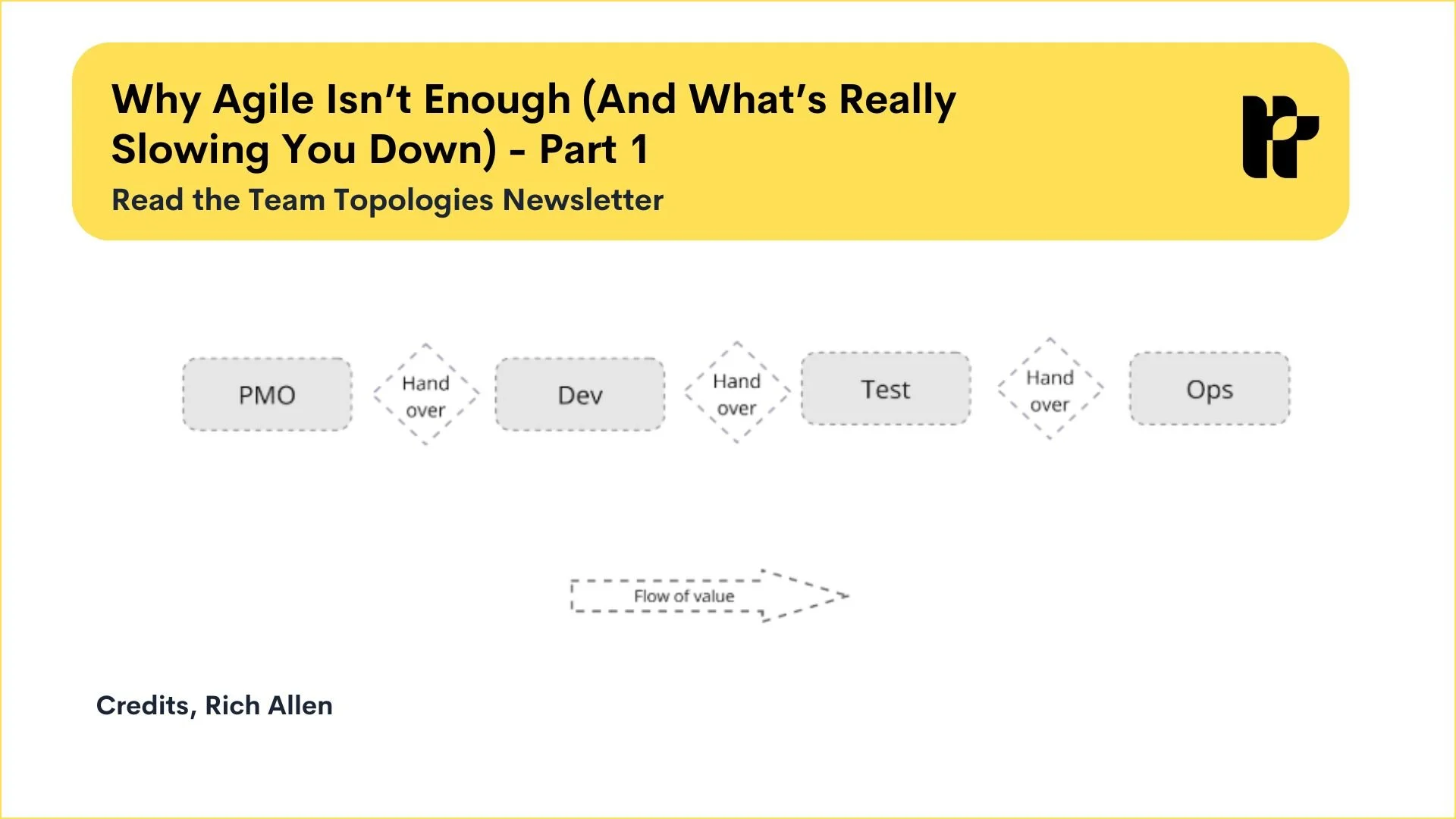Newsletter (July 2024): Blockers to Flow: Addressing and Overcoming Obstacles to Flow with Team Topologies
Flow is essential for an effective and high-performing organization. Matthew Skelton and Manuel Pais, authors of Team Topologies, emphasize that understanding and managing flow blockers can significantly enhance team effectiveness and productivity. Let's explore common blockers to flow and resources to help mitigate these challenges.
Recognizing Common Blockers to Flow
Blocking dependencies & handovers: Teams that rely heavily on each other and frequently pass tasks back and forth experience stalled progress and decreased efficiency, leading to delays and frustration.
High Cognitive Load & Teams Pulled in Many Directions: When teams are overloaded with information and competing tasks, their focus and effectiveness suffer, resulting in lower productivity and higher stress levels.
Unaware of Conway’s Law & Sociotechnical Systems: Ignoring how organizational structures impact system design can lead to misaligned architectures, causing inefficiencies and integration issues.
Org Charts Restricting Communication: Rigid organizational structures that limit cross-team interaction hinder collaboration, slow problem-solving, and reduce innovation.
Identifying and removing these blockers enables organizations to create an environment conducive to fast flow and continuous improvement.
Learn more about identifying these blockers from the 3-hour course on Team Topology Academy
Why You Should Tackle Blockers to Flow
By understanding and mapping out the blockers that exist in your organization you will be likely to see:
Enhanced Productivity: Addressing blockers can boost overall productivity by 20%. Reducing context switching allows teams to focus on high-value tasks and achieve better outcomes.
Improved Software Delivery Performance: Effective management of flow blockers can improve software delivery performance by 30%, as evidenced by DORA metrics.
Financial Savings: Optimizing team workflows can result in significant financial gains. For example, optimizing workflows to prevent 400 engineers from being blocked for an hour daily can save up to €8 million annually.
Increased Job Satisfaction: Teams with fewer blockers report higher job satisfaction, leading to better retention rates and a more motivated workforce.
Ready to fast-track the value stream flow in your organization? Get started
Strategies to Overcome Blockers to Flow
Once you have identified the blockers that prevent your organizations and the teams inside it to focus on high value tasks and deliver a value stream you can look at the following strategies to get started:
Utilize Enabling Teams - Enabling teams help identify and address blockers by providing expertise and resources, enhancing Stream-aligned teams' capabilities without creating long-term dependencies. This allows Stream-aligned teams to focus on primary goals while acquiring necessary skills. Learn more from the Academy course.
Minimize Dependencies and Handovers - Reducing dependencies and handovers between teams is crucial. Organizations should strive to reduce these by ensuring that Stream-aligned teams have the autonomy to manage their work end-to-end. This can involve re-evaluating team boundaries and responsibilities to minimize the need for handovers, which often introduce delays.
Design Intentional Team Interactions - Creating intentional interaction patterns between teams streamlines processes and reduces waiting times. Clear boundaries and responsibilities prevent confusion and miscommunication, fostering a culture of collaboration and support. To get started you can use Team Interaction Modelling
Focus on Reducing Cognitive Load - Helping teams to simplify the tools they need or stop them from spending too muchtime on things that are not essential to build their products or services helps reduce their “extraneous” cognitive load. That allows the team to use their cognitive load to work on the important business problems at hand. . Read more about how platform teams and enabling teams can reduce cognitive load. You can also start to assess the cognitive load of your team using Teamperature.
Continuous Improvement and Feedback Loops - Regular feedback loops help teams proactively identify what is blocking them, and then work on removing those blockers. For this to work, we need a culture of continuous improvement, which allows teams to reflect on their processes and interactions, adapting to challenges.
What’s Coming Up Next?
Expert Leadership Masterclass: Nimble, Humane Organizations with the Authors of Team Topologies
#DL Summit 2024: Optimizing software team interactions with the Team Topologies approach
Check out the full list of events to see which one is best suited for you. If we missed any, send us an email and we will list it and spread the word.
Ready to unblock your organization or at least to identify what is keeping you back from achieving fast flow? Learn more about “Blockers to Fast Flow”
Join the Community
We are happy to enrich the practice of The Team Topologies with new ideas and best practices. This is why the community plays a crucial role in ever-evolving. A warm welcome to our newest members:
If you're passionate about Team Topologies and want to become an advocate, we would love to have you join us. Or, if you have a story to share, we would be honored to feature it on the website.
Was this newsletter useful? Please share your thoughts on how we can make it better. Send us an email.












